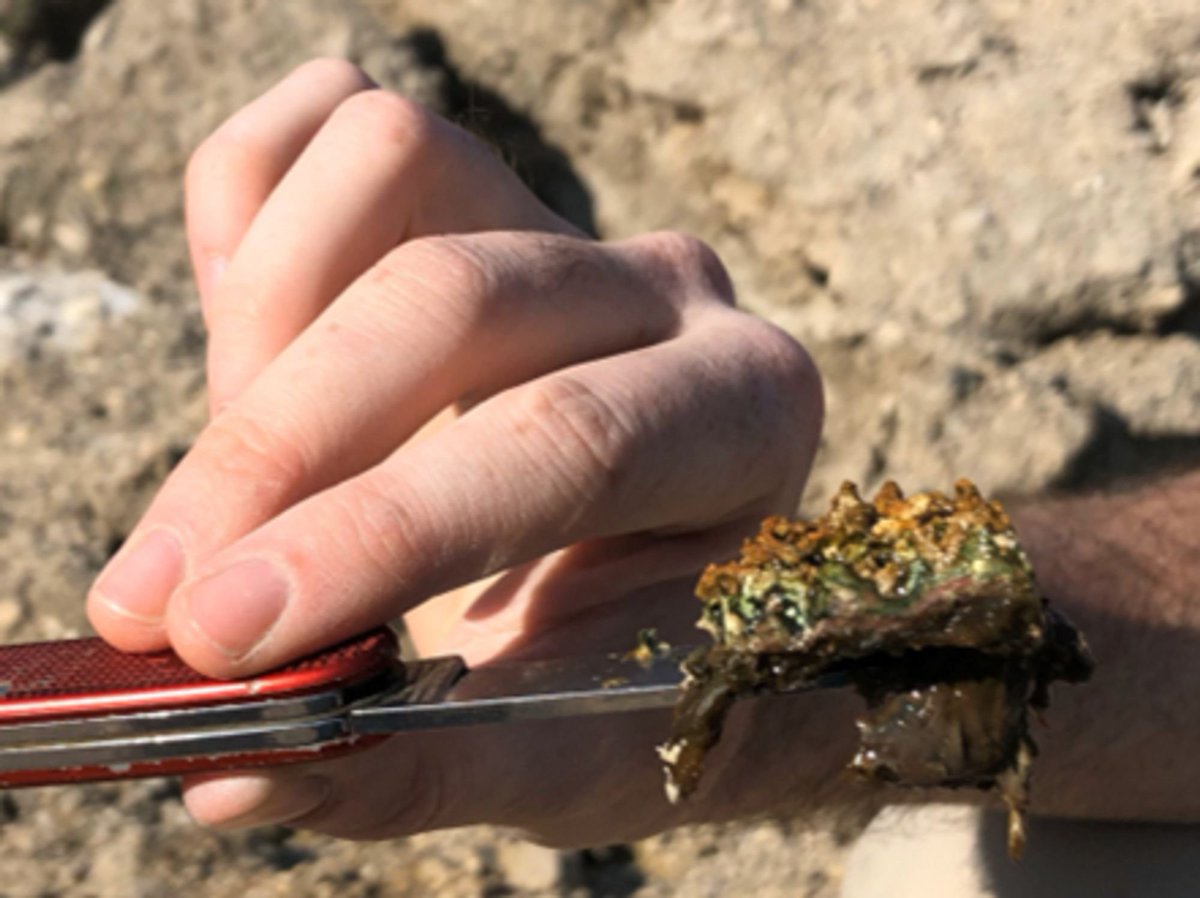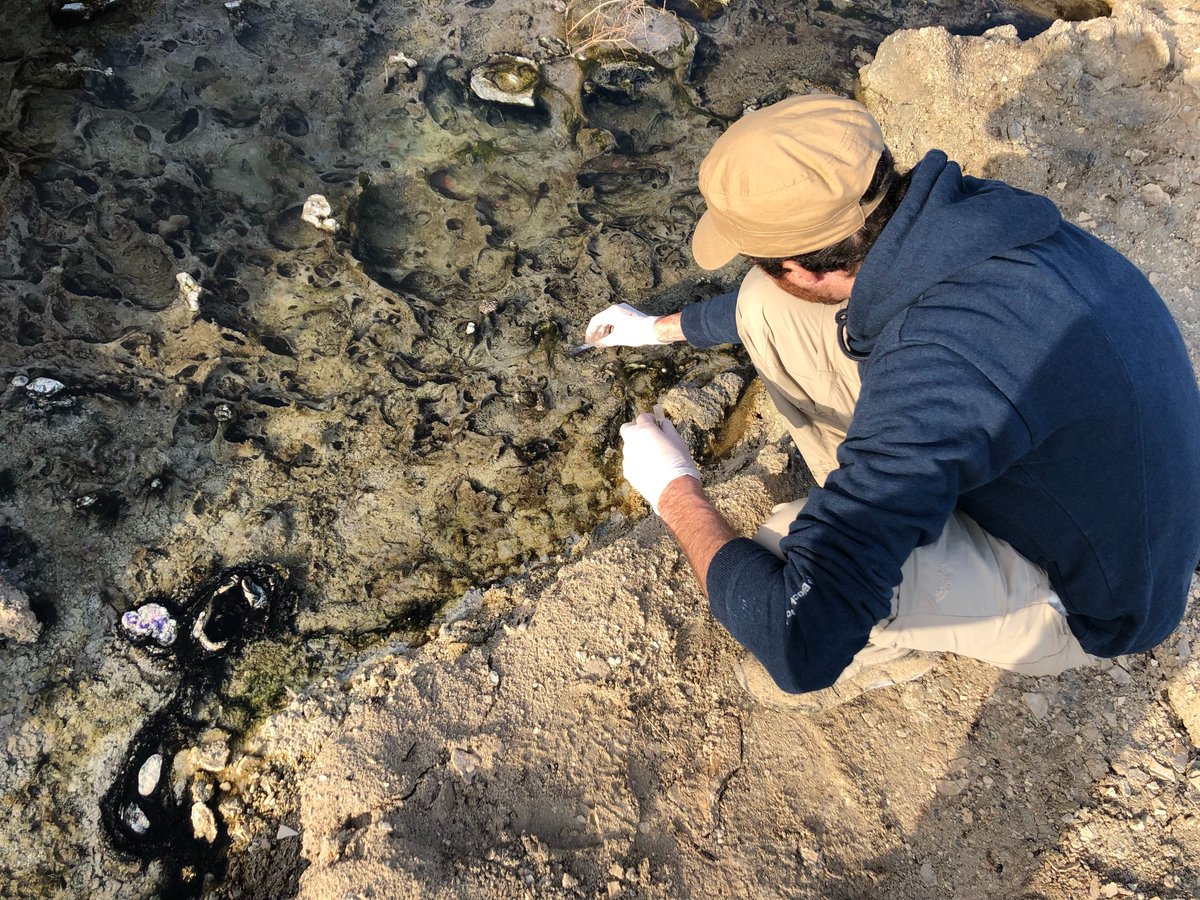New paper published in @AGU_GCubed :
Here is a summary of a work that started during the pandemic and led me towards new techniques and new collaborations, and a fun story to tell
#arsenic #DeadSea #geobiology @snsf_ch @unige_enagupubs.onlinelibrary.wiley.com/doi/full/10.10…
Here is a summary of a work that started during the pandemic and led me towards new techniques and new collaborations, and a fun story to tell
#arsenic #DeadSea #geobiology @snsf_ch @unige_enagupubs.onlinelibrary.wiley.com/doi/full/10.10…
It started with fieldwork by the Dead Sea shores, where sinkholes are formed by the circulation of fresher water in the evaporitic subsurface. The lake retreats by ca. 1m/year, leaving halite and gypsum that can be readily dissolved. A lot of springs emerge in those systems 2/n 

Varied colors are formed by microbial communities developing in pools/sinkholes thanks to the dilution of Dead Sea brine. Salinity is lower there than in the lake, where no photosynthetic activity can be sustained. Mixed minerals also influence the color (photo Tzvika Stein). 3/n 

Sinkholes form along the Dead Sea shore & follow the lake retreat mainly caused by human activity pumping water for agriculture and to extract minerals in giant evaporative pans. 10 yrs ago, the Dead Sea Works was the 4th largest potash production company in the world. 4/n 

Sinkholes have become a hazard in this region, as roads and constructions have also been affected, leaving activities to be displaced or abandoned (see Closson & Abu Karaki 2008 for example 5/n abc.net.au/news/2021-06-1…
From a geology and biology perspective, sinkholes also form new ecosystems, oasis of microbial life in an extreme environment. Some see the development of microbial mats and build-ups that can resemble some of the oldest traces of life on Earth. 6/n bbc.com/travel/article…
As we visited these sinkholes in the Dead Sea, with @DAriztegui, A. Agnon and N. Gedulter, we found some of these ecosystems with different t° or salinity, which lead to changes in how the microbes looked like. Some were purple or green, some aggregated, with minerals, or not 7/n 

@DAriztegui One pool caught our attention as it had a well laminated and mineralized microbial mat somehow looking similar as some of the oldest stromatolites recovered from Western Australia for example. 8/n 

@DAriztegui We eventually sampled many of them, for their DNA, chemistry, microscopic investigation and laboratory growth. Then went back to our lab in 🇨🇭 @UNIGEnews , and prepared for the next steps. That was January 2020... 😷 

@DAriztegui @UNIGEnews Covid lockdown started. Our microbial communities, although adapted to extreme environments could hardly be monitored & we were missing many supplies. So we abandoned part of the project, & redirected to analyses easier to postpone or delay. Life found its way though 10/n 

@DAriztegui @UNIGEnews We cut the mats stored frozen in pieces to map their chemistry under microXRF... & found something: a super high peak in arsenic, not expected at all in the Dead Sea, but observed in other extreme microbial mats, like in the Salar de Atacama, Chile 11/n theconversation.com/ancient-microb…
@DAriztegui @UNIGEnews Arsenic can be very toxic to life & studies have suggested that arsenic-fueled photosynthesis could be the ancestor of the oxygen-producing photosynthesis, that has forever changed Earth's environment and fate. nature.com/articles/s4324…
@DAriztegui @UNIGEnews So we went a little bit further to try to understand what was the nature of this arsenic enrichment. I created a poster explaining the step by step process for a congress. I will continue the 🧵 to explain it 13/n 

@DAriztegui @UNIGEnews We mapped arsenic more closely in the mat, using XRF and particle-induced X-ray emissions, for quantification of numerous elements at high resolution. Arsenic was tied to other elements like Mg, Si, and Mn. This was in collaboration w/ @CNRS_IN2P3 Stephanie Sorieul. 14/n 

@DAriztegui @UNIGEnews @CNRS_IN2P3 We also quantified As by triple quadrupole ICP-MS in the water of the pond, & the sediment. A hard task as it was super low and the Dead Sea chemistry is always a mess to analyse. It was done by @AmandaMOehlert & @ClementPollier @univmiami 15/n amandaoehlert.weebly.com
@DAriztegui @UNIGEnews @CNRS_IN2P3 @AmandaMOehlert @ClementPollier @univmiami We found that arsenic was 6.5 MILLION times higher in some location of the mat, than in the water of the pool it was lying in. This is huge and hard to envision for us, and shows how weird these systems are. 16/n
@DAriztegui @UNIGEnews @CNRS_IN2P3 @AmandaMOehlert @ClementPollier @univmiami Arsenic is a group 1 human carcinogen, contaminating food and groundwater. Knowing how it has been mobilized/immobilized in nature is very important. So we tried to investigate under what form it was in the mat by going to the Swiss Light Source synchrotron of @psich_en 17/n 

@DAriztegui @UNIGEnews @CNRS_IN2P3 @AmandaMOehlert @ClementPollier @univmiami @psich_en In collaboration with Montserrat Filella from Univ. Geneva and Dario Ferreira Sanchez, we interpreted most of the arsenic to be linked with organic elements, under the form of oxidized arsenic. 18/n 

@DAriztegui @UNIGEnews @CNRS_IN2P3 @AmandaMOehlert @ClementPollier @univmiami @psich_en This tells us that arsenic is not in its most dangerous form, and that most of the mat had a similar composition in terms of arsenic. Also, arsenic has been bond to organic matter by a specific process, yet to be evidenced. 19/n 

@DAriztegui @UNIGEnews @CNRS_IN2P3 @AmandaMOehlert @ClementPollier @univmiami @psich_en By looking at this mat under epifluorescent microscope, we indeed noticed that where arsenic could be mapped, organic matter was prevailing, under the form of exopolymeric substance produced by diverse communities, including filamentous cyanobacteria. 20/n 

@DAriztegui @UNIGEnews @CNRS_IN2P3 @AmandaMOehlert @ClementPollier @univmiami @psich_en Our hypothesis was that some of these communities could be linked to the cycling of this arsenic. Photosyntehtic microbes had in the past been associated to arsenotrophy, for example in Lake Mono, by pioneers studies (see Ron Oremland 🕊️and his team). 21/nastrobiology.nasa.gov/news/astrobiol…
@DAriztegui @UNIGEnews @CNRS_IN2P3 @AmandaMOehlert @ClementPollier @univmiami @psich_en Work by P. Visscher and co-authors found genes that could be related to anoxygenic photosynthesis in anoxic mats of Salar de Atacama. Our metagenomics work, in collab. with @ionescu_danny (@LeibnizIGB) could only find genes associated to arsenic detoxification 22/n 

@DAriztegui @UNIGEnews @CNRS_IN2P3 @AmandaMOehlert @ClementPollier @univmiami @psich_en @ionescu_danny @LeibnizIGB These results show that microbes living in the mat can get rid of poisonous material by transforming arsenic contaminants into less mobile and toxic organoarsenic molecules we find today accumulated in the Dead Sea mat. 23/n 

@DAriztegui @UNIGEnews @CNRS_IN2P3 @AmandaMOehlert @ClementPollier @univmiami @psich_en @ionescu_danny @LeibnizIGB This is a quite common phenomenon. Most living cells can perform this operation. So this is not a very sexy result. But it suggests that this mechanism can permit to accumulate arsenic to very high levels in microbial mats of the environment. But why? 24/n
@DAriztegui @UNIGEnews @CNRS_IN2P3 @AmandaMOehlert @ClementPollier @univmiami @psich_en @ionescu_danny @LeibnizIGB We are not sure about it. For the 1st time, arsenic is detected to this levels around the Dead Sea, but pulses are not uncommon in groundwater systems, especially dynamic ones. The Dead Sea sinkholes migration patterns by Abelson et al. (2017) shows how dynamic it can get. 25/n 

@DAriztegui @UNIGEnews @CNRS_IN2P3 @AmandaMOehlert @ClementPollier @univmiami @psich_en @ionescu_danny @LeibnizIGB so here we suspect that at some point, a large pulse of arsenic was naturally (?) released in our pool, triggering a protection and detoxification reaction by the microbial mat, working hardly to store arsenic as non-toxic organoarsenics, away from the cells, in their EPS. 26/n 

@DAriztegui @UNIGEnews @CNRS_IN2P3 @AmandaMOehlert @ClementPollier @univmiami @psich_en @ionescu_danny @LeibnizIGB This was likely a rare event, that could not be measured in the water when we sampled it, but which can be recorded in microbial mats. If time and conditions allow, it can then be potentially preserved in an organic lamina when the microbes build up a stromatolite. 27/ 

@DAriztegui @UNIGEnews @CNRS_IN2P3 @AmandaMOehlert @ClementPollier @univmiami @psich_en @ionescu_danny @LeibnizIGB Organic and arsenic-rich lamina were found in Archean stromatolites, like the 2.7Ga Tumbiana Formation, Australia. They were interpreted to bear some of the first occurrences of anaerobic methane oxidation, nitrification, denitrification & arsenotrophy (Sforna et al., 2014) 28/n 

@DAriztegui @UNIGEnews @CNRS_IN2P3 @AmandaMOehlert @ClementPollier @univmiami @psich_en @ionescu_danny @LeibnizIGB In conclusion, while we do not question here the interpretations of fossil stromatolites, our Dead Sea example presents an extreme case where huge arsenic concentrations can be potentially recorded in a fossil as a result of arsenic detoxification, and not arsenotrophy. 29/n 

@DAriztegui @UNIGEnews @CNRS_IN2P3 @AmandaMOehlert @ClementPollier @univmiami @psich_en @ionescu_danny @LeibnizIGB It is a trace of life in a very active environment exhibiting arsenic pulses. Arsenic is stored in organic matter, and not in minerals (for now). It also provides additional information for using biofilms to decontaminate arsenic from groundwater. 30/n who.int/news-room/fact…
@DAriztegui @UNIGEnews @CNRS_IN2P3 @AmandaMOehlert @ClementPollier @univmiami @psich_en @ionescu_danny @LeibnizIGB If you’ve managed to read until here, I thank you very much🙏and remain available if you have questions. I also wanted to show how some science can emerge out of weird situations e.g. a carefully planned project 🧪, disturbed by a global pandemic 😷, sprinkled by lucky findings🍀
@DAriztegui @UNIGEnews @CNRS_IN2P3 @AmandaMOehlert @ClementPollier @univmiami @psich_en @ionescu_danny @LeibnizIGB one thing that emerged during the pandemic time was the normalization of contacting people worldwide, to discuss and possibly collaborate. It allowed this project to take this direction and eventually be finalized. It worked also for other projects (poke @sedimentologika)
@DAriztegui @UNIGEnews @CNRS_IN2P3 @AmandaMOehlert @ClementPollier @univmiami @psich_en @ionescu_danny @LeibnizIGB @sedimentologika some key articles on Tumbiana Stromatolites I used Sforna et al., 2014
Marin-Carbonne et al., 2018 Lepot et al., 2019
Thomazo et al., 2011 32/nnature.com/articles/ngeo2…
onlinelibrary.wiley.com/doi/10.1111/gb…
sciencedirect.com/science/articl…
onlinelibrary.wiley.com/doi/10.1111/j.…
Marin-Carbonne et al., 2018 Lepot et al., 2019
Thomazo et al., 2011 32/nnature.com/articles/ngeo2…
onlinelibrary.wiley.com/doi/10.1111/gb…
sciencedirect.com/science/articl…
onlinelibrary.wiley.com/doi/10.1111/j.…
@DAriztegui @UNIGEnews @CNRS_IN2P3 @AmandaMOehlert @ClementPollier @univmiami @psich_en @ionescu_danny @LeibnizIGB @sedimentologika Sinkhole and Dead Sea studies
Abelson et al., 2017
Closson & Abou Karaki et al., 2008
Ionescu et al., 2012
Dead Sea works study : agupubs.onlinelibrary.wiley.com/doi/full/10.10…
link.springer.com/article/10.100…
journals.plos.org/plosone/articl…
web.archive.org/web/2011071615…
Abelson et al., 2017
Closson & Abou Karaki et al., 2008
Ionescu et al., 2012
Dead Sea works study : agupubs.onlinelibrary.wiley.com/doi/full/10.10…
link.springer.com/article/10.100…
journals.plos.org/plosone/articl…
web.archive.org/web/2011071615…
@DAriztegui @UNIGEnews @CNRS_IN2P3 @AmandaMOehlert @ClementPollier @univmiami @psich_en @ionescu_danny @LeibnizIGB @sedimentologika and the most beautiful pictures of the sinkholes 🤩
34/34 flickr.com/photos/4749018…

34/34 flickr.com/photos/4749018…

@threadreaderapp unroll
• • •
Missing some Tweet in this thread? You can try to
force a refresh




